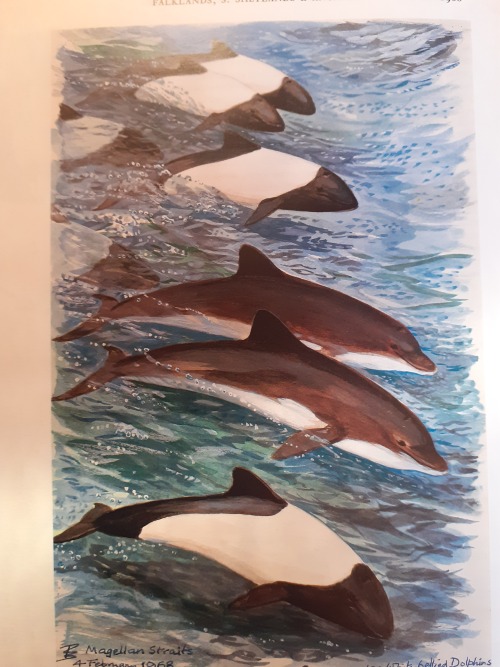Rhincodon-cynocephalus - Thylacines And Whalesharks
More Posts from Rhincodon-cynocephalus and Others





Starry Seas part 2 for Redbubble!
(part 1)
(part 3)

Cryptid dolphins. Sir Peter Scott recorded unusual dolphins accompanying Commerson’s dolphins on an expedition to Antarctica as recorded in his Travels of a Naturalist book, they may be Chilean dolphins or something quite different.
illustration, Sir Peter Scott from Travels of a Naturalist.

The main difference between Darkwing’s and Negaduck’s relationships with their daughters

salmon (real life)
Meet the largest family of living sharks today—deep-sea catsharks.
Deep-sea catsharks are the largest family of living sharks today, with more than 90 species. Catsharks were named for their long, cat-like eyes that are specialized for seeing in low light conditions. These a-meow-zing sharks can be found up to 2,200 meters (7,200 feet) below the surface and grow up to 75 centimeters (30 inches).

MBARI has observed several deep-sea catshark species, for example, the brown catshark (Apristurus brunneus), longnose catshark (Apristurus kampae), lollipop catshark (Cephalurus cephalus), and filetail catshark (Parmaturus xaniurus). Most catsharks lay elaborate clusters of egg cases. The eggs can take up to two years to develop. Tough egg cases, made of keratin protect the developing embryos from predators. A changing ocean means an uncertain future for catsharks. Warming waters could affect developing embryos, and expanding low-oxygen zones could displace adult populations.
GIRL you are GLOWING! GIRL you are RADIOACTIVE! GIRL it's FATAL!
Pandemic, war, and ecological collapse are on my mind.

Ballpoint on heavy paper.
Beautiful!!!!!


Long time no tumblr!






come enjoy the warmth and coziness of this forest hut

🔥 Rhincodon typus using its filter feeding strategy to create a vortex near the surface and have an easy dinner.
-
 xx-slavi-lad-xoxo liked this · 5 months ago
xx-slavi-lad-xoxo liked this · 5 months ago -
 definitelyreckless liked this · 6 months ago
definitelyreckless liked this · 6 months ago -
 ppulverse reblogged this · 7 months ago
ppulverse reblogged this · 7 months ago -
 wingsr liked this · 11 months ago
wingsr liked this · 11 months ago -
 memoryoflife reblogged this · 11 months ago
memoryoflife reblogged this · 11 months ago -
 thevoidwatches reblogged this · 11 months ago
thevoidwatches reblogged this · 11 months ago -
 scarfanon reblogged this · 11 months ago
scarfanon reblogged this · 11 months ago -
 scarfanon liked this · 11 months ago
scarfanon liked this · 11 months ago -
 hidden-driveways liked this · 11 months ago
hidden-driveways liked this · 11 months ago -
 p0tat0pal reblogged this · 11 months ago
p0tat0pal reblogged this · 11 months ago -
 cutepicsformydarling reblogged this · 11 months ago
cutepicsformydarling reblogged this · 11 months ago -
 trashwizzard reblogged this · 11 months ago
trashwizzard reblogged this · 11 months ago -
 petmimi reblogged this · 11 months ago
petmimi reblogged this · 11 months ago -
 trashy-milifilou liked this · 11 months ago
trashy-milifilou liked this · 11 months ago -
 theorigamiphoenix reblogged this · 11 months ago
theorigamiphoenix reblogged this · 11 months ago -
 thedeepestpuddle reblogged this · 11 months ago
thedeepestpuddle reblogged this · 11 months ago -
 thedeepestpuddle liked this · 11 months ago
thedeepestpuddle liked this · 11 months ago -
 mixedberrysocialanxietydisorder liked this · 1 year ago
mixedberrysocialanxietydisorder liked this · 1 year ago -
 mokia reblogged this · 1 year ago
mokia reblogged this · 1 year ago -
 thevoidwatches liked this · 1 year ago
thevoidwatches liked this · 1 year ago -
 vmunroe liked this · 1 year ago
vmunroe liked this · 1 year ago -
 theothin reblogged this · 1 year ago
theothin reblogged this · 1 year ago -
 theothin liked this · 1 year ago
theothin liked this · 1 year ago -
 torimouto reblogged this · 1 year ago
torimouto reblogged this · 1 year ago -
 mrbrokenlifexxx25 liked this · 1 year ago
mrbrokenlifexxx25 liked this · 1 year ago -
 pumpkin-hotchocolate reblogged this · 1 year ago
pumpkin-hotchocolate reblogged this · 1 year ago -
 leatherbelt1295 liked this · 1 year ago
leatherbelt1295 liked this · 1 year ago -
 kirbyddd reblogged this · 1 year ago
kirbyddd reblogged this · 1 year ago -
 stayfm reblogged this · 1 year ago
stayfm reblogged this · 1 year ago -
 alicorn-marrow liked this · 1 year ago
alicorn-marrow liked this · 1 year ago -
 honeybulldyke liked this · 1 year ago
honeybulldyke liked this · 1 year ago -
 crypticjynx liked this · 1 year ago
crypticjynx liked this · 1 year ago -
 1863-project liked this · 1 year ago
1863-project liked this · 1 year ago -
 shotsofnovacaine reblogged this · 1 year ago
shotsofnovacaine reblogged this · 1 year ago -
 coochiecarnage reblogged this · 1 year ago
coochiecarnage reblogged this · 1 year ago -
 devotedlychaoticcrusade liked this · 1 year ago
devotedlychaoticcrusade liked this · 1 year ago -
 hoennprincess liked this · 1 year ago
hoennprincess liked this · 1 year ago -
 cleardriam6 liked this · 1 year ago
cleardriam6 liked this · 1 year ago -
 legalize-arson reblogged this · 1 year ago
legalize-arson reblogged this · 1 year ago -
 hivyn reblogged this · 1 year ago
hivyn reblogged this · 1 year ago -
 wizard-of-stars reblogged this · 1 year ago
wizard-of-stars reblogged this · 1 year ago -
 creativerule34hentaineverdie reblogged this · 2 years ago
creativerule34hentaineverdie reblogged this · 2 years ago -
 lostandyearning liked this · 2 years ago
lostandyearning liked this · 2 years ago -
 lindit reblogged this · 2 years ago
lindit reblogged this · 2 years ago -
 hakunapiccata reblogged this · 2 years ago
hakunapiccata reblogged this · 2 years ago -
 m3d1c4l liked this · 2 years ago
m3d1c4l liked this · 2 years ago -
 purpulse liked this · 2 years ago
purpulse liked this · 2 years ago -
 pyrosomatic-metamorphosis reblogged this · 2 years ago
pyrosomatic-metamorphosis reblogged this · 2 years ago

Thylacine archive blog: @moonlight-wolf-archive
204 posts